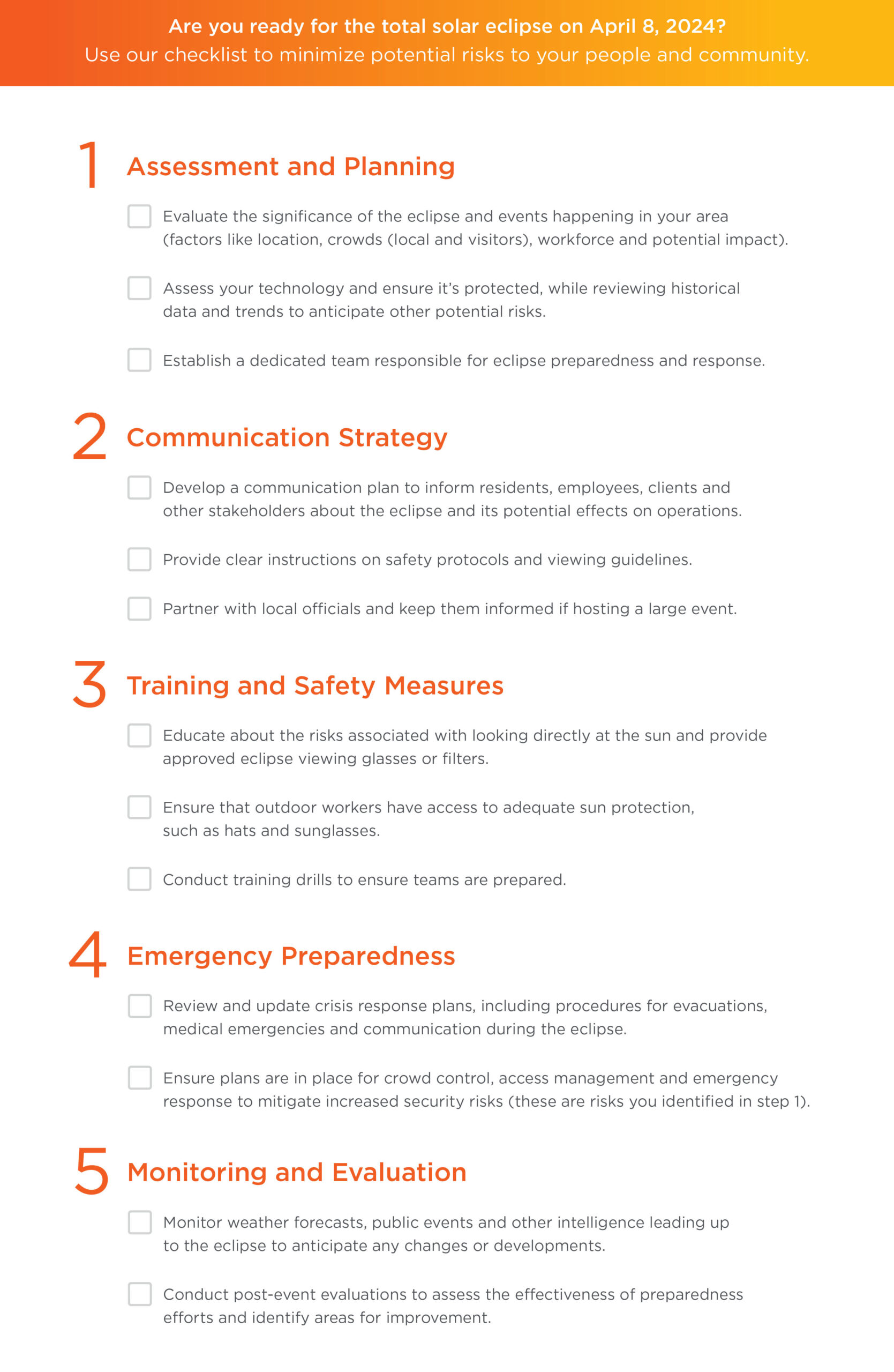On April 8, 2024, crowds of astronomy buffs and everyday stargazers alike will be poised to marvel as the moon casts its shadow over earth. If your community is in the path of totality for the total solar eclipse, now’s the time to prepare for this golden opportunity.
The total solar eclipse, also known as the Great American Eclipse and the Great North American Eclipse, is a celestial wonder that will bring a unique set of challenges and opportunities when it comes to public and employee safety, as well as business continuity. With a proactive strategy and (and a checklist to help you minimize risk), government agencies, businesses and organizations can collaborate to prepare their communities to be starstruck in safety.
4 Tips to Elevate Your Community’s Solar Eclipse 2024 Experience
1. Prioritize Public Safety for Residents and Visitors.
An estimated one to four million travelers are bound for locations with prime viewing for the upcoming total solar eclipse. The path of totality will begin in Mexico, cut a diagonal line through the U.S. and then make its way through the maritime provinces of Canada.
Twelve U.S. states are in the path of totality. Texas is expected to have the highest number of visitors, followed by Indiana and Ohio. The major cities inside the path are Mazatlán, Torreon, San Antonio, Austin, Dallas, Fort Worth, Indianapolis, Cleveland, Buffalo, Rochester, Syracuse and Montreal. This influx of people can strain local resources and create a daunting task for public safety officials and emergency managers.
To protect the well-being of both residents and visitors, city officials will have to conduct crowd management. While monitoring and directing foot traffic, they’ll also have to address a range of other logistical variables and have a way to inform everyone about them. A proactive plan for critical communications, including mass notification technology, is the best way to make this happen. From reminders about the importance of eye protection to notices of road closures, a reliable and intuitive system makes it easy to send alerts in just a few clicks.
The result? Local officials and emergency managers can alleviate stress and create a smooth (and safe) viewing experience for the entire community.
2. Prepare for Traffic Congestion and Increased Emergency Services.
Depending on the locations of the most popular vantage points, vehicular traffic and parking will be concerns before, during and after the event. Significantly higher traffic congestion poses a road safety hazard. To combat this risk, public safety officials will need to be poised to coordinate their efforts around a higher-than-usual rate of traffic accidents.
With the increased traffic, population density and excitement around the eclipse, it’s also possible for both crime and medical emergencies to spike. Compounding factors like the weather, the conditions of roads and sidewalks, and the age and health of spectators can all lead to incidents like falls, heart attacks and dehydration. Planning in advance is key to a swift and effective response to emergencies in a crowded area.
Mass alerting enables public safety officials to coordinate the efforts of local transportation agencies, police, fire and emergency medical services. Targeted messages to specific groups as well as two-way communications improves the capability to:
- Implement traffic control measures.
- Provide alternate routes.
- Direct people to appropriate facilities.
- Shorten emergency response times.
Taking time in advance to evaluate your critical event management technology will save cost and effort during the event. More importantly, it can save lives and prevent injuries. A unified platform provides rapid access to protocols and training resources, as well as a forum for instant communications, before, during and after the event. When everyone is on the same page and able to reach each other, both preemptive troubleshooting and incident response are more effective.
3. Plan Ahead for the Business Impact to Maximize Potential and Avoid Disruption.
While the surge in visitors may lead to higher sales volume and rates of interaction for local businesses and organizations, it can also bring a number of operational disruptions. Closed roadways can hinder the delivery of supplies to your premises as well as the output of your products to customers. Meanwhile, congested sidewalks may block access to your primary entryway and require more (or bigger) signage to make people aware you’re open.
A convenient system for mass notifications makes it easy to address these and other operational challenges associated with large community events. With just a few clicks on your preferred device, you can let existing customers know in advance of upcoming changes, such as changes to your hours of operation and/or exclusive promotions related to the eclipse event. Features like preset contact groups and messaging templates allow for quick and convenient mass texts, so you can focus on your core business tasks.
4. Prioritize Employee Safety and Communications.
To accommodate operational adjustments, it’s likely you’ll be making changes to your employee schedules. Depending on your business model, you may decide to shift on-premises workers to remote status, or vice versa. You may need to increase or decrease staff coverage. And because events like the eclipse require special equipment, you’ll need to notify everyone of when and where to obtain and use eye protection.
When employees are signed up for mass notifications in advance, implementing these changes becomes easier for everyone involved. Managers can send out shift change notices and offer additional hours in a format that allows everyone to respond and sign up instantly, without the hassle of time-consuming phone trees. And if circumstances change during the event, such as notifying incoming employees to stay home or on-premises employees to leave, geo-targeted alerts ensure everyone gets the right message.
Your Comprehensive Checklist for Public and Private Planning
By working together, government agencies, commercial businesses and organizations can minimize potential risks and maximize engagement and safety during the eclipse.
With this downloadable checklist as a starting point and critical event management technology in place, every community in the path of totality can enjoy the benefits of a safe and productive eclipse viewing.
Click the image to download the checklist.
OnSolve, Your Partner in Eclipse Preparedness
Ready to get started? OnSolve is here to help. As an industry leader in critical event management technology, we have the expertise and support you need. Prepare today so you can shine during the Great American Solar Eclipse.


